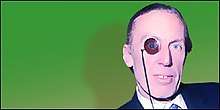Christopher Ewart-Biggs
Christopher Thomas Ewart Ewart-Biggs, CMG, OBE (5 August 1921 – 21 July 1976) was the British Ambassador to the Republic of Ireland, an author and senior Foreign Office liaison officer with MI6. He was killed in 1976 by the Provisional Irish Republican Army in Sandyford, Dublin.
Christopher Ewart-Biggs CMG, OBE | |
|---|---|
 | |
| British Ambassador to Ireland | |
| In office 9 July 1976 – 21 July 1976 | |
| Monarch | Elizabeth II |
| Prime Minister | James Callaghan |
| Preceded by | Sir Arthur Galsworthy |
| Succeeded by | Robin Haydon |
| Personal details | |
| Born | 5 August 1921 Thanet, Kent, England |
| Died | 21 July 1976 (aged 54) Sandyford, Dublin, Ireland |
| Spouse(s) | Mary Raines Gavrelle Thomas
( m. 1952; died 1959) |
| Children | 3 |
| Education | Wellington College |
| Alma mater | University College, Oxford |
| Military service | |
| Allegiance | United Kingdom |
| Branch/service | British Army |
| Unit | Royal West Kent Regiment |
| Battles/wars | Second World War |
His widow, Jane Ewart-Biggs, became a Life Peer in the House of Lords, campaigned to improve Anglo-Irish relations and established the Christopher Ewart-Biggs Memorial Prize for literature.
Early life and career
Christopher Thomas Ewart-Biggs was born in the Thanet district of Kent to Captain Henry Ewart-Biggs of the Royal Engineers and his wife Mollie Brice. He was educated at Wellington College and University College, Oxford and served in the Royal West Kent Regiment of the British Army during the Second World War. At the Second Battle of El Alamein in 1942 he lost his right eye and as a result he wore a smoked-glass monocle over an artificial eye.
Ewart-Biggs joined the Foreign Service in 1949, serving in the Lebanon, Qatar and Algiers, as well as Manila, Brussels and Paris.[1]
Death
Ewart-Biggs was 55 when he was killed by a land mine planted by the IRA on 21 July 1976.[2] He had been taking precautions to avoid such an incident since coming to Dublin only two weeks before. Among the measures he employed was to vary his route many times a week but, at a vulnerable spot on the road connecting his residence to the main road, there was only a choice between left or right. He chose right, and approximately 150 yards from the residence, hit a landmine that was later judged to contain hundreds of pounds of explosives. Ewart-Biggs and fellow passenger and civil servant Judith Cooke (aged 26) were killed. Driver Brian O'Driscoll and third passenger Brian Cubbon (aged 57, the highest-ranking civil servant in Northern Ireland at the time) were injured.[3]
Manhunt
The Irish government launched a manhunt involving 4,000 Gardaí and 2,000 soldiers.[4] Taoiseach Liam Cosgrave declared that "this atrocity fills all decent Irish people with a sense of shame."[5] In London, the UK Prime Minister James Callaghan condemned the assassins as a "common enemy whom we must destroy or be destroyed by".[4] Thirteen suspected members of the IRA were arrested during raids as the British and Irish governments attempted to apprehend the criminals, but no one was ever convicted of the killings. In 2006 released Foreign and Commonwealth Office files revealed that the Gardaí had matched a partial fingerprint at the scene to Martin Taylor, an IRA member suspected of gun running from the United States.[2]
See also
- List of Ambassadors from the United Kingdom to Ireland
References
- "Devoted diplomat who abhorred violence". Irish Times. 25 July 2001.
- "Ireland and the death of the ambassador". Daily Telegraph. 29 December 2006.
- Collins, Liam. "UK diplomat's murder on lonely Dublin road triggered State crisis". Irish Independent.
- "Trial by Fire in Dublin". Time. 2 August 1976. Archived from the original on 20 February 2011.
- Weinraub, Bernard (22 July 1976). "Britain's Envoy in Dublin Killed by Mine". New York Times.
External links
- Christopher Ewart-Biggs Assassinated 1976, RTÉ News, 22 July 1976
| Diplomatic posts | ||
|---|---|---|
| Preceded by Arthur Galsworthy |
British Ambassador to Ireland 1976 |
Succeeded by Walter Robert Haydon |